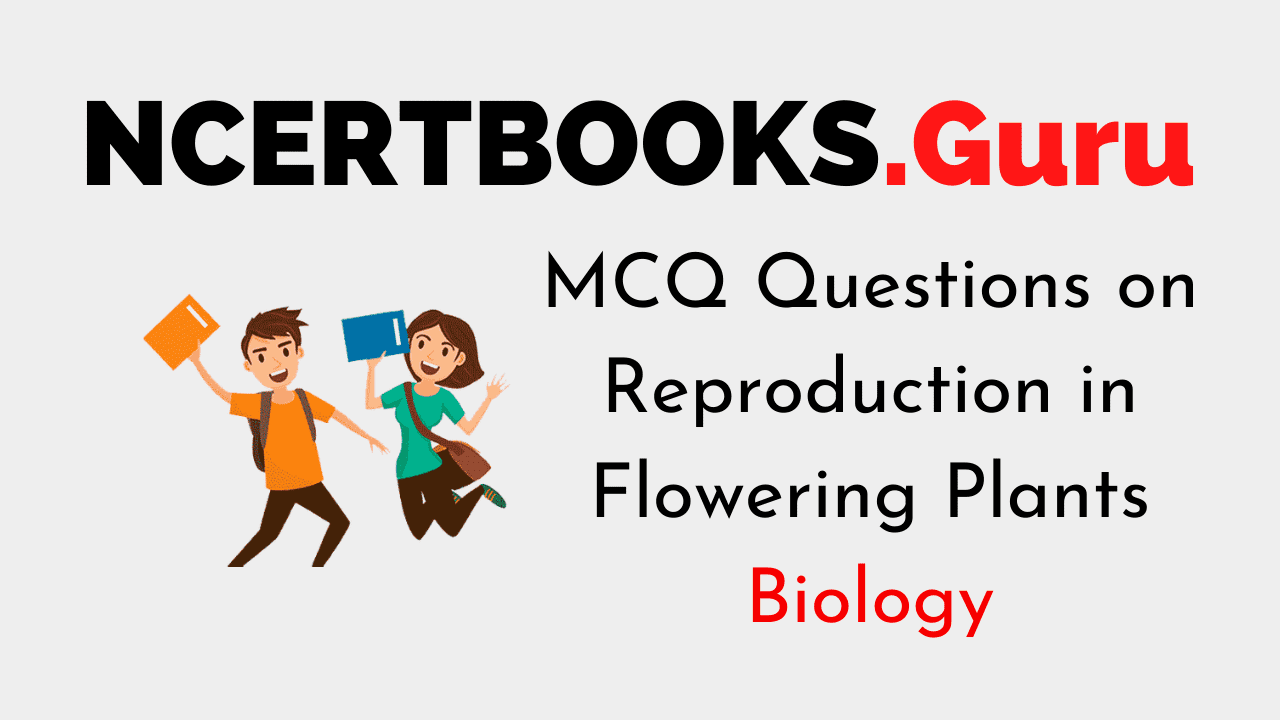MCQ Questions on Reproduction in Flowering Plants
1. Flowers with both androecium and gynoecium are called
(a) Bisexual flowers
(b) Anther
(c) Stamens
(d) Unisexual flowers
Answer
Answer: (a) Bisexual flowers
2. The transfer of pollen from the anther to stigma is called
(a) Pollination
(b) Fertilization
(c) Adoption
(d) Diffusion
Answer
Answer: (a) Pollination
3. The fusion of female reproductive nucleus with the male reproductive nucleus is known as
(a) Adoption
(b) Excretion
(c) Fertilization
(d) Regeneration
Answer
Answer: (c) Fertilization
4. The two nuclei at the end of the pollen tube are called
(a) Tube nucleus and a generative nucleus
(b) Sperm and ovum
(c) Generative nucleus and stigma
(d) Tube nucleus and sperm
Answer
Answer: (a) Tube nucleus and a generative nucleus
5. Generative nucleus divides forming
(a) 2 male nuclei
(b) 3 male nuclei
(c) 2 female nuclei
(d) 3 female nuclei
Answer
Answer: (a) 2 male nuclei
6. Embryo sac is located inside the
(a) Stigma
(b) Ovule
(c) Micropyle
(d) Style
Answer
Answer: (b) Ovule
7. One nucleus of the pollen tube and secondary nucleus of the ovum grow into
(a) Stigma
(b) Endosperm
(c) Anther
(d) Stamen
Answer
Answer: (b) Endosperm
8. The stalk of Datura flower at its base is known as
(a) Pedicel
(b) Corolla
(c) Sepals
(d) Thalamus
Answer
Answer: (a) Pedicel
9. The male reproductive parts of a flower, the stamens, are collectively known as
(a) Androecium
(b) Filament
(c) Anther
(d) Gynoecium
Answer
Answer: (a) Androecium
10. The other name for gynoecium is
(a) Pistil
(b) Stigma
(c) Androecium
(d) Style
Answer
Answer: (a) Pistil
11. Functional megaspore in a flowering plant develops into
(a) Endosperm
(b) Ovule
(c) Embryo-sac
(d) Embryo
Answer
Answer: (c) Embryo-sac
12. Which of the following is similar to autogamy, but requires pollinators?
(a) Geitonogamy
(b) Cleistogamy
(c) Apogamy
(d) Xenogamy
Answer
Answer: (a) Geitonogamy
13. What is the function of the filiform apparatus?
(a) Guide the entry of pollen tube
(b) Recognize the suitable pollen at the stigma
(c) Produce nectar
(d) Stimulate division of the generative cell
Answer
Answer: (a) Guide the entry of pollen tube
14. A mass of nutritive material outside the embryo sac is called _____
(a) Protoplasm
(b) Pericarp
(c) Ectoderm
(d) Perisperm
Answer
Answer: (d) Perisperm
15. Which of the following statements is correct?
(a) Sporogenous tissue is haploid
(b) The hard outer layer of pollen is called intine
(c) Tapetum nourishes the developing pollen
(d) Microspores are produced by endothecium
Answer
Answer: (c) Tapetum nourishes the developing pollen
16. Which of the following fruit is produced by parthenocarpy?
(a) Brinjal
(b) Apple
(c) Banana
(d) Jackfruit
Answer
Answer: (c) Banana
17. The process of formation of seeds without fertilization in flowering plants is known as
(a) Budding
(b) Apomixis
(c) Sporulation
(d) Somatic hybridization
Answer
Answer: (b) Apomixis
18. Functional megaspore in an angiosperm develops into
(a) Endosperm
(b) Embryo
(c) Embryo-sac
(d) Ovule
Answer
Answer: (c) Embryo-sac
19. Rewards and attractants are required for
(a) Entomophily
(b) Cleistogamy
(c) Anemophily
(d) Hydrophily
Answer
Answer: (a) Entomophily
20. A dioecious flowering plant prevents
(a) Geitonogamy and xenogamy
(b) Autogamy and xenogamy
(c) Autogamy and geitonogamy
(d) Cleistogamy and xenogamy
Answer
Answer: (c) Autogamy and geitonogamy
